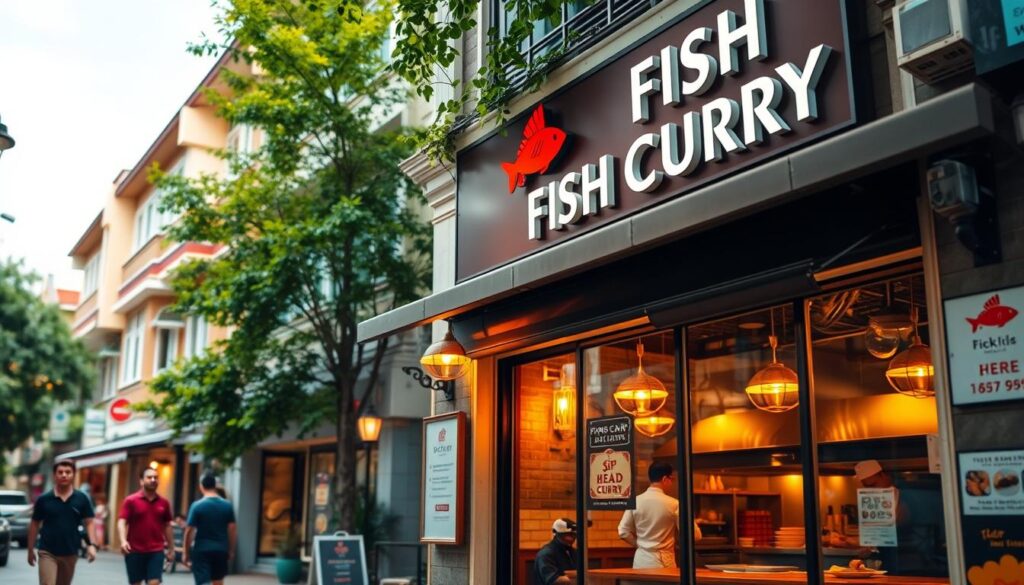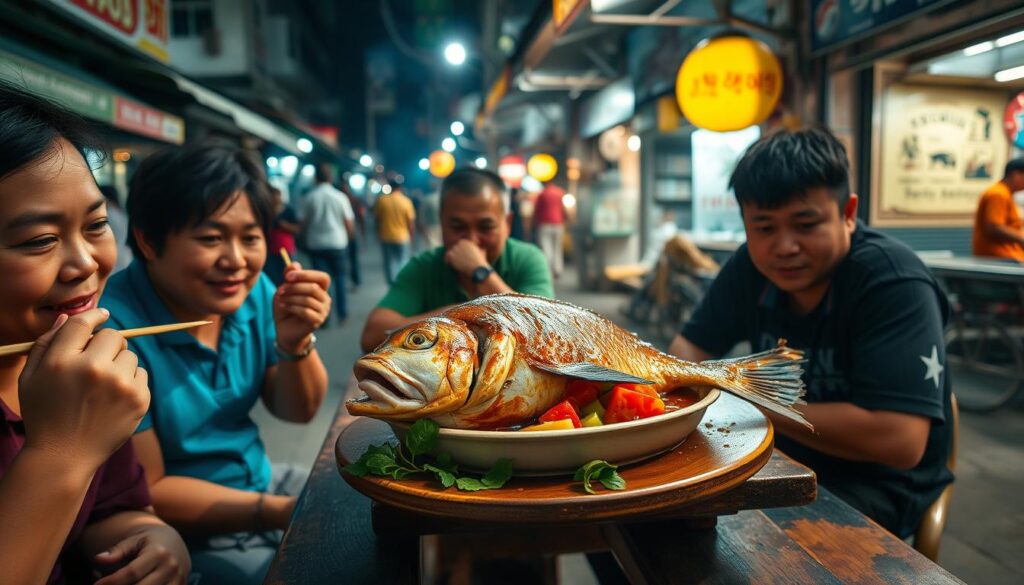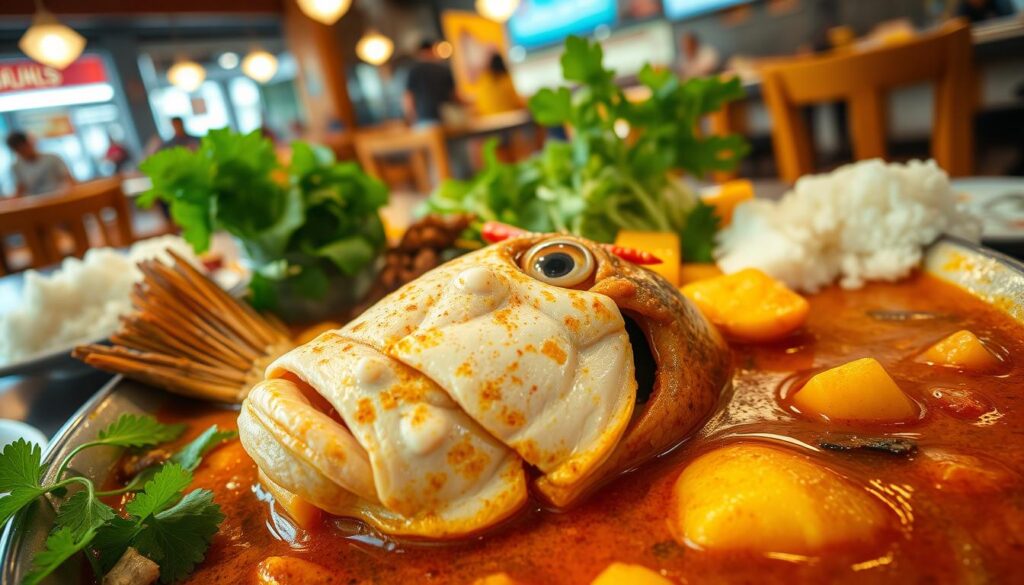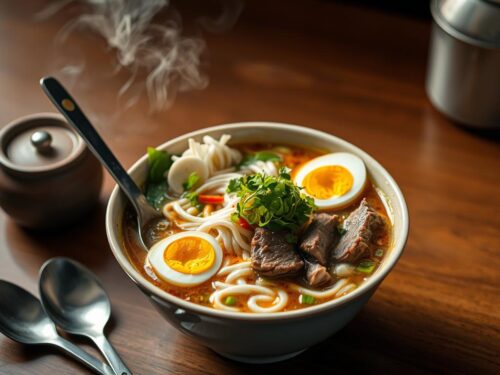Singapore’s food scene is a vibrant mix of cultures, and few dishes capture this fusion like fish head curry. This iconic meal blends Indian spices, Chinese cooking techniques, and Malay flavors into one unforgettable experience. It’s a must-try for locals and visitors alike.
Many top spots use fresh red snapper or sea bass, simmered in a rich, aromatic gravy. Some even earn Michelin Bib Gourmand recognition for their standout versions. Whether you love bold spices or milder flavors, there’s a perfect plate waiting for you.
Below, we’ll explore five standout places serving this beloved dish. Each offers a unique twist, celebrating Singapore’s diverse culinary heritage. Get ready to dig in!
Key Takeaways
- Fish head curry reflects Singapore’s multicultural food culture.
- The dish combines Indian, Chinese, and Malay influences.
- Fresh seafood like red snapper is often used.
- Some restaurants hold Michelin Bib Gourmand honors.
- Five top spots will be featured in this guide.
Introduction to Singapore’s Beloved Fish Head Curry
Chef Gomez’s 1940s innovation remains a crowd favorite today. He crafted this dish to blend Indian spices with Chinese culinary traditions, creating a symbol of Singapore’s multicultural harmony.
The traditional method starts with turmeric-marinated seafood, slow-cooked in claypots. Tamarind or coconut milk forms the base, infusing rich flavours into tender meat. Each bite tells a story of adaptation and creativity.
Cultural Significance
More than a meal, it represents unity. The blend of techniques—Indian spicing, Chinese ingredients—mirrors Singapore’s diverse identity. Families and friends gather around steaming bowls, sharing stories alongside curry fish head.
Key Variations
| Style | Base | Flavor Profile |
|---|---|---|
| Peranakan | Tamarind | Tangy, aromatic |
| Indian | Coconut milk | Creamy, spicy |
Don’t skip the cheeks and eyes—they’re *flavor hotspots*. Silky and rich, they elevate the experience. Whether you prefer bold spices or milder notes, this dish adapts to every palate.
What Makes Fish Head Curry So Special?
The magic of this dish lies in its perfect harmony of textures and bold flavors. Fresh red snapper heads, marinated in turmeric, simmer until the meat becomes silky. The cheeks and eyes, prized for their gelatinous richness, add umami depth.
Vegetables like pineapple, eggplant, and okra soak up the aromatic gravy. Each bite contrasts crispy papadum or fluffy prata with tender seafood. The result? A flavour explosion that’s both comforting and exciting.
Spices play a starring role. Restaurants like Samy’s blend 20+ spices, while others use Peranakan tamarind for tangy notes. Here’s how two styles compare:
| Ingredient | South Indian Style | Peranakan Style |
|---|---|---|
| Base | Coconut milk | Tamarind |
| Key Spice | Fenugreek | Lemongrass |
Turmeric, a staple spice, offers anti-inflammatory benefits. Paired with omega-3-rich seafood, it’s as nutritious as it is delicious. Families often share claypots, making it a communal dish that bridges generations.
Whether you crave fiery chilies or creamy coconut, this meal adapts. It’s a celebration of heritage, health, and pure flavour.
Top 5 Spots for the Best Fish Head Curry in Singapore
From spicy to creamy, these eateries offer standout takes on a local favorite. Each spot brings its own twist—whether it’s a decades-old recipe or a Michelin Bib Gourmand winner. Here’s where to savor every bite.

1. Yu Cun Fish Head Curry
Customize your spice level at this family-friendly spot. Their claypot servings ($24–$26) come packed with tender meat and veggies. Weekday lunch specials make it a hit with office crowds.
2. Muthu’s Curry
A 50-year legacy shines at this Jurong East Street icon. Try their sea bass or snapper ($24–$33), paired with garlic naan. The mango lassi balances the heat perfectly.
3. Samy’s Curry Restaurant
Since the 1960s, Samy’s has served free-flow biryani with their signature gravy ($21–$33). Eat off banana leaves in Dempsey Hill’s lush setting.
4. NaNa Curry
Five-time Michelin Bib Gourmand winner? Yes, please. Their $25–$35 pots include yam and ladyfinger. Bedok’s outlet offers weekday discounts—go early!
5. West Coz Cafe
Halal-certified and hearty, their $28 Assam or coconut curries delight. After your meal, stroll to nearby West Coast Park to soak in the views.
Each eatery offers generous portions and unique flavors. Whether you’re near Jurong East Street or craving a signature twist, there’s a plate waiting for you.
How to Enjoy Fish Head Curry Like a Local
Unlock the full experience of this flavorful meal with insider tips. Locals know the secrets—from pairing to technique—that make every bite unforgettable.

Start with the tender cheeks and eyes, prized for their silky texture. Use flaky prata or crispy papadum to scoop up the rich gravy. It’s a game-changer.
“Sharing a claypot is more than a meal—it’s a celebration of togetherness.”
Popular side dishes balance the spices perfectly. Try these combos:
| Dish | Why It Works |
|---|---|
| Aloo gobi | Creamy potatoes tame the heat |
| Stir-fried kang kong | Fresh greens add crunch |
| Teochew porridge | Mild base lets flavours shine |
Pair with coconut rice for extra richness. For a twist, add pineapple chunks to brighten the dish. Leftover gravy? Toss it with noodles the next day.
Gather friends—this meal thrives on communal joy. Larger claypots mean more variety to savor. Dig in and taste Singapore’s heart.
The History Behind Singapore’s Fish Head Curry
Resourcefulness shaped one of Singapore’s most beloved comfort foods. In the post-war years, Chef Gomez blended cooking techniques from Indian and Chinese kitchens in Little India. His creation used affordable seafood heads, turning scarcity into a flavour revolution.
![]()
Originally inspired by Kerala-style curry, the dish evolved with Nyonya influences. Tamarind added tangy flavours, while coconut milk brought richness. By the 1970s, it became a street food staple—now part of UNESCO-recognized hawker culture.
| Era | Key Change | Impact |
|---|---|---|
| 1940s | Chef Gomez’s adaptation | Fused Indian spices with Chinese preferences |
| 1960s–70s | Nyonya assam integration | Added fruity tang to balance spices |
| Present | Vegan alternatives | Expands accessibility while honoring tradition |
Families passed recipes down like heirlooms. Today, modern twists include vegan “fish” heads made from jackfruit or tofu. Yet the heart remains—a dish born from ingenuity, now a symbol of Singapore’s multicultural culture.
Why Fish Head Curry is a Must-Try in Singapore
What makes this dish so special that it nearly became Singapore’s national food in 2023 polls? Its perfect blend of flavour, culture, and sustainability creates an unforgettable experience.

Ivins’ Peranakan version adds torch ginger for floral aroma—a twist that elevates the taste. Unlike chili crab’s messy indulgence, this dish offers balanced spices and tender textures.
Claypot presentations make it Instagram gold. The steaming bowls at Banana Leaf Apolo ($30.50–$40.50) feed groups photogenically. Food tours always include it on their list.
“Using the whole head honors ‘nose-to-tail’ cooking—nothing goes to waste.”
Locals love how one pot serves 3–4 people. Shared meals turn into cultural celebrations, especially during festivals. Every spoonful tells Singapore’s story.
From its vibrant taste to its photogenic appeal, this meal is more than food—it’s a sensory journey through Singapore’s heart.
Tips for First-Time Fish Head Curry Eaters
New to this iconic dish? Here’s how to dive in without hesitation. Start with smaller portions if you’re unsure—NaNa’s half-servings ($25) are perfect for solo diners.
Spice levels can be adjusted. At Samy’s, ask for “less chili padi” if you prefer milder flavours. Jurong West Claypot balances heat with pineapple for a tangy twist.
Pick the right size: 1–2kg heads feed four comfortably. The meat near the cheeks is the most tender—don’t miss it! Pair with vegetables like okra or eggplant for texture.
“Weekday lunch specials save time and money—go before noon to beat the rush.”
Peak hours at Yu Cun or Muthu’s mean long queues. Plan your day wisely. Wet wipes are handy; this is a hands-on, saucy experience.
For halal choices, try West Coz Cafe or Banana Leaf Apolo. Their claypots are generous, so bring friends to share the joy.
Conclusion
Every bite of this iconic dish tells a story of tradition and innovation. From Yu Cun’s customizable spice levels to NaNa’s Michelin-worthy gravy, each spot offers something special.
Try both styles—creamy Indian curry fish head and tangy Peranakan versions. For a deeper dive, join local food tours to uncover hidden gems.
Growing up, my family’s claypot nights turned this meal into laughter-filled memories. Whether at restaurants or home, fish head curry brings people together—just like Singapore itself.



